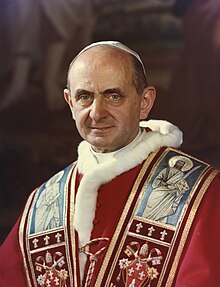Pope Paul VI
Saint Pope Paul VI | |
|---|---|
 | |
| Papacy began | June 21, 1963 |
| Papacy ended | August 6, 1978 |
| Predecessor | Pope John XXIII |
| Successor | Pope John Paul I |
| Personal details | |
| Birth name | Giovanni Battista Enrico Antonio Maria Montini |
| Born | September 26, 1897 Concesio, Italy |
| Died | August 6, 1978 Castel Gandolfo, Italy |
| Motto | Cum Ipso in Monte (With Him on the mount) In Nomine Domini (In the name of the Lord) |
| Sainthood | |
| Feast day | September, 26 |
| Beatified | October 19, 2014 St. Peter's Square, Vatican City by Pope Francis |
| Canonized | October 14, 2018 St. Peter's Square, Vatican City by Pope Francis |
| Other popes named Paul | |
Pope Paul VI (Latin: Paulus PP. VI; Italian: Paolo VI), born Giovanni Battista Enrico Antonio Maria Montini, was an Italian priest of the Roman Catholic Church and the 263rd Pope from 1963 until his death in 1978.[1] Paul was a spiritual leader and the head of the church bureaucracy.[2] Pope Benedict XVI declared in 2012 that Paul had lived “a life of heroic virtue.” Two years later he was beatified by Pope Francis. He was canonized by the same pope in October 2018.[3]
Early life[change | change source]
Montini was born in Concesio. That is near Brescia in northern Italy. His father was editor of a Roman Catholic newspaper.[4] He received degrees in civil and canon law, theology and philosophy.[5]
Before the papacy[change | change source]
Montini was ordained and celebrated his first mass in 1920.[4] He worked in the Vatican diplomatic corps.[5] During World War II, he was in charge of the Vatican's work for refugees and prisoners of war.[5] He was made Archbishop of Milan in 1954.[5] Pope John XXIII made Montini a cardinal in 1958.[4]
Pope[change | change source]
Cardinal Montini was elected Pope in 1963.[4] Pope Paul continued the Second Vatican Council which was begun by Pope John XXIII.[6] His first encyclical is the only one in the Vatican archives which is in the handwriting of the pope who delivered it.[7] Paul VI was known as the "pilgrim" pope for his numerous travels.[8] He was the first pope to fly in an airplane.[9]
In 1964, Paul was the first pope to travel from Rome to the Holy Land.[5] He flew first to Amman in Jordan. Then he traveled by car to Jerusalem.[10] In 1970, the pope visited Australia, the Phillipines,[11] and Indonesia.[12] In 1975, Paul declared 1975 to be a "jubilee" year with themes of renewal and reconciliation.[13]
In 1978, Prime Minister Aldo Moro was kidnapped in Rome. Pope Paul VI made an offer to exchange his life for Moro's.[14] The offer was not accepted. Moro was killed 55 days later.[15]
Death[change | change source]
At the age of 80, Pope Paul VI died at Castel Gandolfo, Italy, from a heart attack.[16]
Legacy[change | change source]
The Pope Paul VI Hall is the modern building in which mass papal audiences are held.[17]
Related pages[change | change source]
References[change | change source]

- ↑ "List of Popes," Catholic Encyclopedia (2009); retrieved 2011-11-02.
- ↑ Briggs, Kenneth A. "Pope Paul VI Is Dead of a Heart Attack at 80; Guided the Church Through Era of Change," New York Times. August 7, 1978; retrieved 2011-10-30.
- ↑ "Saint Paul VI | Biography, Second Vatican Council, & Legacy | Britannica". www.britannica.com. Retrieved 2022-09-04.
- ↑ 4.0 4.1 4.2 4.3 Cortesi, Arnaldo. "Cardinal Montini Elected Pope," The New York Times. June 22, 1963; retrieved 2011-10-30.
- ↑ 5.0 5.1 5.2 5.3 5.4 "Faces of the Milennium: Pope Paul VI (1897-1978)," New York Times. 1999; retrieved 2011-10-30.
- ↑ Cortesi, Arnaldo. "Pope Says in Talk He Will Continue Vatican Council," New York Times. June 23, 1963; retrieved 2011-10-30.
- ↑ Doty, Robert C. "Pope Paul VI Completes Second Year of Reign," New York Times. June 21, 1965; retrieved 2011-10-30.
- ↑ "Roman Catholics: Pope as Pilgrim," Archived 2011-12-13 at the Wayback Machine Time. December 11, 1964; "Pope visited Ephesus and Virgin Mary House in Turkey" Archived 2011-08-27 at the Wayback Machine; excerpt, "Pope Benedict XVI is the third pope who became a 'pilgrim'.... Pope Paul VI and Pope John Paul II were the other two popes who visited the House of Virgin Mary and became 'pilgrims'."
- ↑ "Pilgrim Popes," Archived 2011-10-03 at the Wayback Machine Vatican Radio; retrieved 2011-10-30.
- ↑ Hoffmann, Paul. "Paul VI Starts Trip To the Holy Land," New York Times. January 4, 1964; retrieved 2011-10-30.
- ↑ Hoffman, Paul. "Pope Will Visit Philippines and Australia," New York Times. May 30, 1970; retrieved 2011-10-30.
- ↑ Kamm, Henry. "Moslems, Hindus and Buddhists Join Pope at Mass in Jakarta," New York Times. December 4, 1970; retrieved 2011-10-30.
- ↑ "The Jubilee in Church History," Archived 2011-11-23 at the Wayback Machine Eternal Word Television Network (EWTN); retrieved 2011-10-30.
- ↑ "Pope OKs miracle for Paul VI in sainthood process". The Japan Times.com. Retrieved September 19, 2014.[permanent dead link]
- ↑ Holmes, J. Derek, and Bernard W. Bickers. A Short History of the Catholic Church. London: Burns and Oates, 1983. 291.
- ↑ Hebblethwaite 1993, p. 707.
- ↑ Hofmann, Paul. "When in Rome, How to Attend a Papal Audience," New York Times. February 11, 1979; retrieved 2011-10-30.
More reading[change | change source]
Serafian, Michael. (1964). The Pilgrim. New York: Farrar, Straus. OCLC 386084?
Other websites[change | change source]
![]() Media related to Paulus VI at Wikimedia Commons
Media related to Paulus VI at Wikimedia Commons
- Vatican webpage, Paul VI biography
- Catholic Hierarchy, Pope Paul VI
- Cardinals of the Holy Roman Church, Cardinal Montini
| Preceded by John XXIII |
Pope 1963–1978 |
Succeeded by John Paul I |
